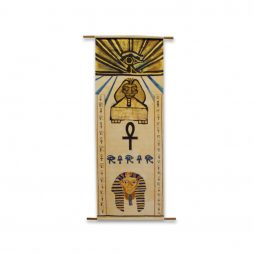

It was previously thought that the Admonitions of Ipuwer presents an objective portrait of Egypt in the First Intermediate Period. It is a textual lamentation, close to Sumerian City Laments and to Egyptian laments for the dead, using the past (the destruction of Memphis at the end of the Old Kingdom) as a gloomy backdrop to an ideal future. The Admonitions is considered the world's earliest known treatise on political ethics, suggesting that a good king is one who controls unjust officials, thus carrying out the will of the gods. The Ipuwer Papyrus has been dated no earlier than the Nineteenth Dynasty, around 1250 BCE but the text itself is much older, and dated back no earlier than the late Twelfth Dynasty of the Egyptian Middle Kingdom.

It is likely that the poem concluded with a reply of the Lord of All, or prophesying the coming of a powerful king who would restore order. The story continues with the recalling of better days until it abruptly ends due to the missing final part of the papyrus. This is followed by a vivid description of the disorders: there is no longer any respect for the law and even the king's burial inside the pyramid has been desecrated. He demands that the Lord of All (a title which could refer to either the king or the creator sun-god) destroy his enemies and remember his religious duties. In the poem, Ipuwer – a name typical of the period 1850–1450 BCE – complains that the world has been turned upside-down: a woman who had not a single box now owns furniture, a girl who used to look at her face in the water now has a mirror, while the once-rich man is now in rags. In 1828, Anastasi sold the papyrus to the Dutch government. The Ipuwer Papyrus was discovered by such unprofessional traders, who sold it to Giovanni Anastasi, who served as Consul in Egypt for Sweden and Norway. Discovery ĭuring the first half of the 19th century, many Egyptian ancient artifacts were discovered in Egypt by either scholars or merchants who tried to make a quick profit.

It contains the Admonitions of Ipuwer, an incomplete literary work whose original composition is dated no earlier than the late Twelfth Dynasty of Egypt (c.1991–1803 BCE). The Ipuwer Papyrus (officially Papyrus Leiden I 344 recto) is an ancient Egyptian hieratic papyrus made during the Nineteenth Dynasty of Egypt, and now held in the Rijksmuseum van Oudheden in Leiden, Netherlands. Lastly, they left them out in the sun to dry! To have more space for writing, drawing, or painting, the ancient Egyptians would paste papyrus sheets together to form larger sheets.Ancient Egyptian hieratic papyrus made during the Nineteenth Dynasty Ipuwer Papyrus The plant’s sticky, glue-like sap held the strips together. Ancient Egyptians took the stem layers from the plant and sliced them into thin strips, just like you did with your brown paper bags! Then, they laid them out in rows, dampened them, and pressed them together into a sheet. Papyrus paper was made from the Cyperus papyrus plant, a common grass-like plant that was native to river banks and marshy areas. How did the ancient Egyptians make papyrus? The word hieroglyphics comes from the Greek word hiero, which means “holy,” and glyphics, which means “writings.” So hieroglyphics means “holy writings.” The ancient Egyptians used these hieroglyphics to record and explain their world and events, all of which were closely intertwined with their religion. So they invented a form of writing called hieroglyphics. The ancient Egyptians thought it was important to write things down. Bring on the history! Why were hieroglyphics created?


 0 kommentar(er)
0 kommentar(er)
